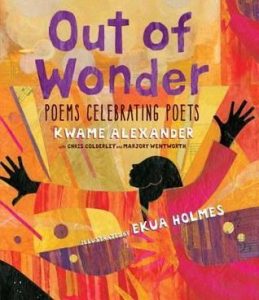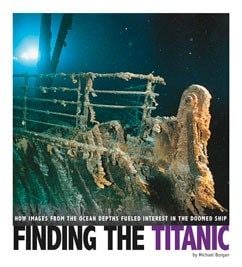Alexander, Kwame and Chris Colderley and Marjory Wentworth. Out of Wonder: Celebrating Poets. Candlewick Press, 2017. 9780763680947. 41p. $16.99. Gr. 3-6.
A collection of poems by three different poets illustrated beautifully by Ekua Holmes. This compilation is separated into three different sections and all the poems are modeled after the author’s poet heroes. “Imitation is the highest form of flattery” as the saying goes, and this book has poems styled after legends from Emily Dickinson and Robert Frost to Langston Hughes and Nikki Giovanni. THOUGHTS: This is a diverse and modern collection to add to your poetry section. It would be a wonderful starting off point for a poetry unit to study any of the poets within.
Poetry Emily Woodward, The Baldwin School
Captured Science History. Compass Point, 2018. $25.99ea. $103.96 set of four. 64 p. Gr. 5-9.
Burgan, Michael. Finding the Titanic. 978-0-7565-5642-6.
Nardo, Don. Hubble Deep Field. 978-0-7565-5643-3.
Smith-Llera, Danielle. Double Helix. 978-0-7565-5642-6.
Smith-Llera, Danielle. Mars Rover. 978-0-7565-5641-9.
The goal of the Captured Science History series is to show how photography captures moments that can affect science, influence scientists and average citizens and change history. Each volume spotlights an important scientific find/event with historical significance. This reviewer had the opportunity evaluate Finding the Titanic: How Images from the Ocean Depths Fueled Interest in the Doomed Ship. This volume offers a brief history of the Titanic and examines the search for the vessel and it’s ultimate discovery in 1985. The science behind the search and the search ships and submersibles is also discussed. The book concludes with information about ongoing exploration of the Titanic and a discussion of the public’s continuing fascination with the ship. Numerous photographs accompany the text, including historic photos of the ship, photos from the 1985 search and discovery of the Titanic, as well as more recent images. THOUGHTS: These titles will appeal to readers with an interest in science or history (or both!). Each volume features attractive, high quality photos and illustrations. Recommended for secondary collections.
500s, 900s, Science, History Elizabeth Henry, Lampeter-Strasburg SD
Rubin, Susan Goldman. The Quilts of Gee’s Bend. Abrams Books for Young Readers, 2017. $21.95 56 pp. 978-14197-21311 Gr. 5 and up.
For the women of Gee’s Bend, Alabama, quilting has always been a part of life. Rubin shares the history of the Pettway family from slavery in 1845, through tenant farmers striving for just-out-of-reach land ownership, through the Civil Rights Movement, to current day descendants of those farmers. In each generation, quilts were made and often individually designed with skill–for remembrance and for warmth. Materials included anything at hand: denim work shirts, flour sacks, corduroy couch cushions, and scraps of anything; “when I was growing up, you threw nothing away” (6). Some quilters followed patterns such as “Housetop,” “Log Cabin,” “Bricklayer,” or “Star.” Others designed based on what fabrics they had: “You find the colors and the shapes and certain fabrics that work our right, kind of like working a puzzle” explains quilter Mary L. Bennett (14). In 1998, collector Bill Arnett saw a photo of a Gee’s Bend quilt and was determined to learn more. The artistry of the works astounded Arnett, who founded a nonprofit “to collect and preserve the quilts” and in 2002 created an exhibit to show the quilts. Soon, sales of the book brought income and pride to the quiltmakers. Rubin has managed to succinctly tell a fascinating history that includes quilters’ words and time period photographs. But it is the photographs of the quilts themselves that takes your breath away. Bold colors, intricate designs, inventive shapes and varied fabrics make for stunning visuals. Rubin includes simple instructions for how to make a quilt square, furthering this shared artistic endeavor. THOUGHTS: An interesting and beautifully presented book that leaves the reader wanting to see more of the quilts. Luckily for us, Rubin closes with notes and bibliography leading to more research.
746 Quiltmaking Melissa Scott, Shenango Area School District



